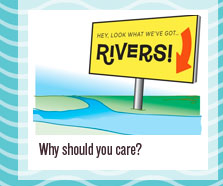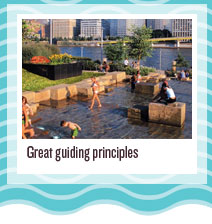Rethinking Our Rivers: An Introduction
a city once defined by its rivers is finally ready to reclaim the waterways and reinvent its identity
Nick Meyer, Trevor Kupfer, Thom Fountain, Kinzy Janssen, photos by Andrea Paulseth, Nick Meyer, Jessica Vollmer |


 |
 |
 |
 |
 |
 |
An Introduction to Our Rivers
So let’s start with the basic history lesson. Early civilizations utilized rivers as sources for drinking/washing water, food, and recreation, praising their convenience and building communities around them. Eventually humans developed ways of controlling rivers via dams and levees to maximize transportation, power, and waste disposal, while also minimizing natural disasters like floods. It was then that many river towns experienced “booms,” and the small commercial and residential developments of old were replaced by large industries. We soon turned our backs on the riverfront, for it had grown dirty and less appealing. But newer and faster forms of transport would outmode many of the river industries, environmental awareness would slowly improve the waters, and increasingly, people would rediscover the appeal of the riverfronts. That about brings us up to date.
When we look back 50 years from now, people will be blown away... if even a fraction of the plans dealing with the riverfront actually come to fruition, things WILL change dramatically.
We Chippewa Vallians have realized our historical folly, and are trying to revamp the Chippewa and Eau Claire rivers into approachable, versatile spaces. As Parks, Recreation, & Forestry Director Phil Fieber said, “It took us 150 years to mess it up, so it’ll take us quite a while to fix it.” Now we’re tearing down old industrial developments (or revitalizing them for other uses) and making way for the three Rs – residential, recreational, and retail development.
The recently-updated Eau Claire Waterways Plan supports developments and tourism along our rivers, lakes, and creeks over the next 20-plus years. The plan states, “The rivers … will play an increasingly important role in economic development. Nowadays, they can and should be the focus of efforts to enhance quality of life, recreation, and sense of place. Those are important factors in attracting the creative class entrepreneurs, visionaries, and business leaders that will nurture innovation that creates jobs in the 21st Century.”
As George Santayana famously said, “Those who cannot remember the past are condemned to repeat it.” In this case, we remember our past, resent the mistakes, long for the liveliness, and are looking for a fresh start.
River animation provided by Scott Welsch
Editors: Nick Meyer, Trevor Kupfer, Thom Fountain
Text: Trevor Kupfer, Nick Meyer, Kinzy Janssen
Design: Josh Smeltzer, Katie Wolff, Nick Meyer
Images: Andrea Paulseth, Nick Meyer
Thanks for the help:
Phil Fieber, Darryl Tufte, Mike Schatz, Ayres Associates, and Project for Public Spaces


















